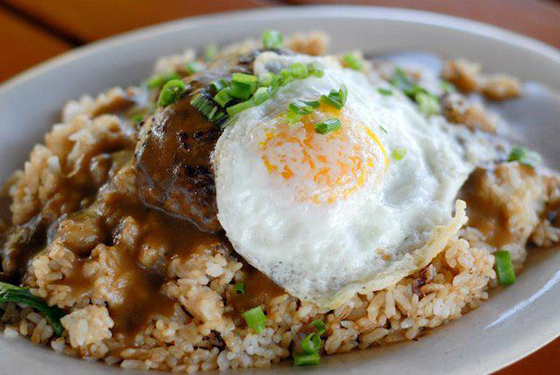This ubiquitous restaurant item -- still found in many places and getting a makeover too -- typically consists of two scoops of rice, a scoop of macaroni salad, and meat such as Hawaiian BBQ, beef teriyaki, kalua pork, chicken katsu or the Loco Moco, a ground beef patty topped with a fried egg and brown gravy. Not exactly local food, and rarely served with a piece of tropical fruit, taro, or fresh-caught fish in sight.
What's different about the latest crop of notable Maui chefs -- who include resort restaurateur Isaac Bancaco (formerly of Humuhumu now at the Pineapple Grill), casual dining standout Sheldon Simeon (Star Noodle and Leoda's), and farmer-forager-pop-up-chef James Simpliciano -- is a renewed focus on collaborating closely with farmers and fishermen and sourcing sustainable ingredients that reflect the many microclimates of Maui. This new breed of cooks embrace a farm-to-table sensibility that many Northern Californians take for granted, and seek to modernize menus, offering food with flair and finesse but in a more casual atmosphere than their culinary trailblazers. And this shift in thinking is taking place at fancy resort restaurants, pop-up farm dinners, and eating establishments in between.
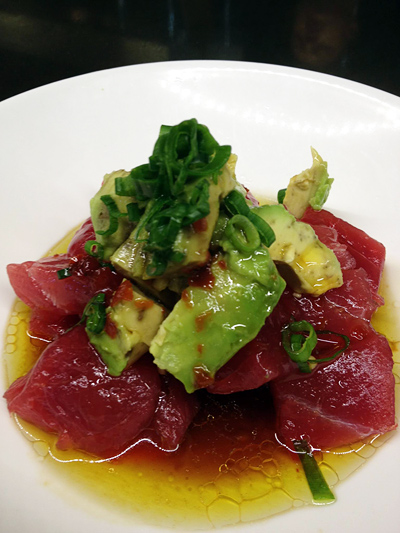
Fresh island flavors with a twist shine at Star Noodle, such as the Avo Ahi with sambal (chili sauce) and usukuchi (soy sauce). Photo: Courtesy Star Noodle
"The new generation of leading Maui chefs have a stronger connection to our local food traditions and food cultures and for the most part they are born and raised in the islands and have a natural affinity to the land, sea, mountains, and valleys," notes Christopher Speere of the Maui Culinary Academy at the University of Hawaii Maui College. "These chefs were raised on pork adobo, ahi poke, kim chee cucumbers, wild guava smoked pork, shoyu braised pork belly and grilled hamachi collars -- island flavors and the use of island ingredients are inherent in their everyday cooking practices. They stay true to their roots and cook from the heart."
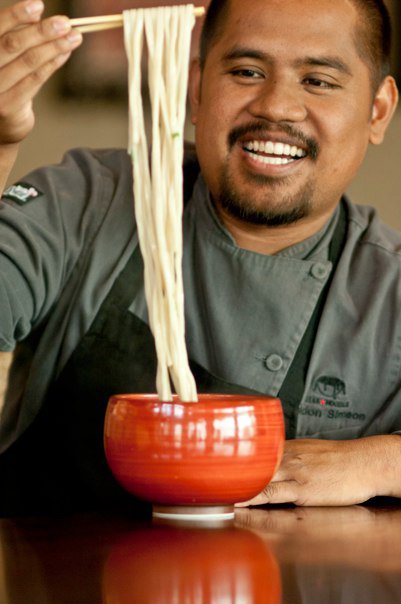
The star behind Star Noodle, Sheldon Simeon. Photo: Courtesy Star Noodle
Case in point James Beard Award-nominee Sheldon Simeon whose Star Noodle -- an Asian-inspired, made-by-hand noodle house in an industrial park near the tourist mecca of Lahaina -- and Leoda's Kitchen and Pie Shop, a roadhouse diner in Olowalu featuring fresh salads, savory pastries, and pies -- have drawn appreciative nods from critics and consumers alike.
Simeon and fellow chefs took off for New York to get ideas and inspiration from noodle bars like David Chang's Momofuku, for Simeon's noodle joint, and it shows in his small plates offering imaginative flavor pairings. Pohole Salad showcases Hana fiddle head ferns, Maui onions, ebi (shrimp), and kombu (seaweed); Lahaina Fried Soup (actually a noodle dish, not soup featuring doubly-thick chow fun, pork, and bean sprouts), and bacon-flecked Brussels Sprouts with Napa cabbage and kimchee puree also wins rave reviews. Desserts include a modern rendition of the popular Portuguese doughnuts known as Malasadas, served with chocolate and butterscotch caramel sauce and chopped peanuts.
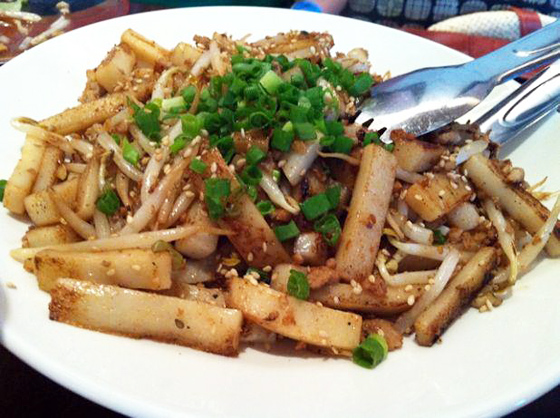
Noodle dishes, such as the Lahaina Fried Soup, feature at Star Noodle. Photo: Courtesy Star Noodle
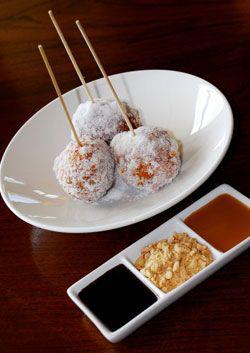
Save room for dessert at Star Noodle. Photo: Courtesy Star Noodle
Similarly, a kitchen crew from Leoda's decamped to the Bay Area to research bread, pies, and pastries at places like Tartine, Mission Pie, and El Porteno Empanadas. On the menu at the roadhouse: a savory corn hand-held pie filled with hibatchi sweet Kula corn, lime zest, cotija cheese, chives, and cilantro, along with hearty chicken or meat 'n potatoes pot pies. Also in the mix: sweet berry pies, flaky crusted yuzu-lemon tart, macadamia nut chocolate praline pie, and coconut cream pie. Sides worth scoping out include the Reuben lumpia (corned beef, sauerkraut, provolone cheese, thousand island dressing) and the fried salad (Brussels sprouts leaves, burnt orange vinaigrette, celery leaves, mixed hydroponic greens, radish, local mint.)
On a recent food and farm trip to Maui, Simeon stopped by this reporter's table at Star Noodle to share his thoughts on the current state of dining on the island. Simeon, originally from Hilo on the Big Island, recently earned a People's Choice Award for Best New Chef/Northwest and Pacific region from Food & Wine magazine. He also appears on season 10 of Bravo's Top Chef, which begins November 7 (he was mum about the show, as one might expect.) But there's nothing celebrity chef-y about this cook: He arrived in a T-shirt, shorts, and slippers (island speak for flip flops) en route to his second baby luau of the night. (A first birthday luau is a grand celebration, he and another local informed me. Naturally, food plays a starring role in such events.)
He's a humble guy who comes from a food-loving clan (his dad born and raised Hawaiian, his mom from a Filipino family). Simeon is happy for his restaurants' success and also quietly striving to do more to feature Hawaiian farmers who grow local gems -- he thinks it's time for restaurant chefs like him to step aside and place the spotlight on what growers are doing to improve food in Maui.
"It's an honor to showcase local ingredients and incorporate local culture in the dishes we serve," he says. "As a chef I like to introduce customers -- locals and visitors -- to flavors they can't find anywhere else."
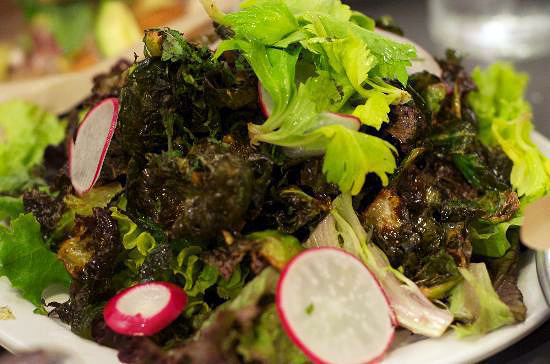
The fried salad at Leoda's features Brussels sprouts coated in a kicky dressing. Photo: Courtesy Leoda's
His wildly popular Brussels sprouts dishes at both hot spots illustrate some of the challenges inherent with island culinary life. Simeon concedes Brussels sprouts showed up on his menus as part of a national trend, and now they're too big a hit to come off. But these cruciferous vegetables are flown in from the mainland. So he's working with farmers in cooler areas on the island, who can grow small Brussels sprouts for a short season, and hopes to switch to this homegrown crop for however long they last and educate diners about seasonal eating along the way.
Food writer Bonnie Friedman says much has changed on the plate in the 30 years she's called Maui home -- despite the island's limited resources. "When I first arrived here in terms of 'fine dining,' most places were serving frozen mahimahi, frozen vegetables, a baked potato and calling it a day," says Friedman, who leads local food tours designed to whisk visitors away from the resort areas and into the small towns where local people live, work, and eat. She passes on "name" places for holes-in-the-walls in central Maui, mom-and-pop shops, cowboy country fare, and gas-station grub to highlight what she calls the island's "amazing melting pot of ethnic cuisines." There's always a shave ice stop too.
Not everyone is enamored with the current state of island eats -- notably newbies from the mainland. At O'o Farm in Kula Country, a growing region on the island's west side, the resident chef on a farm and lunch tour there -- who relocated from food-centric Seattle for the gig -- maintains that island food is 5 to 15 years behind what's on plates Stateside and says he hasn't been wowed by anything he's eaten while out and about in the eight months or so he's lived on Maui.
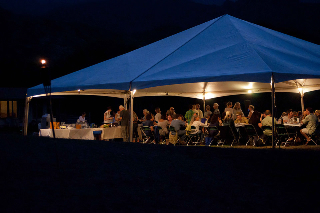
Pop-up dining, Hawaiian style, at Kupu Maui. Photo: Monica George
No matter, for the most part, locals are content to do their own thing without emulating mainland trends -- or at least giving them a refreshing island feel. Take a recent pop-up dinner, old hat in the Bay Area for sure. But this event, sponsored by the local chapter of Slow Food, had a distinctly island vibe: James Simpliciano, who grows greens and has worked in the kitchens of large resorts, dished up dinner on protected land while local musician Joel Katz played Hawaiian steel guitar. Proceeds from these events benefit local groups -- the spirit of giving back to the community is alive and well in the land of aloha -- in this case the Hawaiian Islands Land Trust.
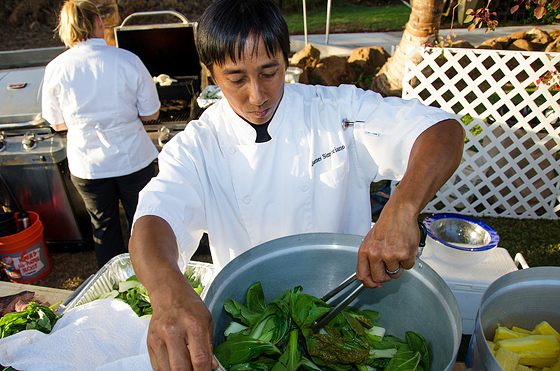
Farmer-chef James Simpliciano cooks for the pop-up crowd. Photo: Peter Liu, Kaiscapes Media/Flickr
This pop-up event, dubbed Kupu Maui, (kupu means sprout in Hawaiian) was held at Waihe'e Coastal Dunes and Wetlands Refuge, a quiet, pristine, shoreline plot home to eight different endangered species. On the menu that night pupu (bite-sized appetizers) such as chai-smoked pork with lilikoi (passion fruit) jelly and micro greens on taro chip (a vegetarian version showcased local goat cheese). The main meal served buffet-style included a lamb tagine with aromatic Maui onion mire poix, Honakahau taro, Kapalua sweet potato, Ka'anapali carrots, beets, garlic and Hawaiian sea salt. Much of the food was donated by local farmers and prepared by a crew of local cooks. Kupu Maui pops up once a month at a different location, frequently a farm. For instance, last Saturday the event was held at Kupa'a Farm, an organic grower whose produce sells out within hours at the UpCountry Farmers' Market on Saturdays.
It's true much of what is consumed on Maui is still imported from the mainland, perhaps not surprising for an isolated island a five-hour flight from San Francisco. But increasingly, resident chefs feature homegrown food for the same reasons the rest of us seek local eats -- health, environment, economics, sustainability, taste, terroir -- and a dash of well-deserved local pride.

